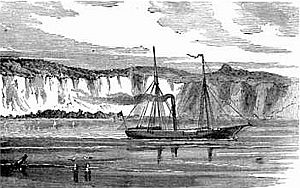Ellis Cliffs, Mississippi facts for kids
Quick facts for kids
Ellis Cliffs, Mississippi
|
|
|---|---|

A view of Ellis Cliffs in 1896
|
|
| Country | United States |
| State | Mississippi |
| County | Adams |
| Elevation | 66 ft (20 m) |
| Time zone | UTC-6 (Central (CST)) |
| • Summer (DST) | UTC-5 (CDT) |
| GNIS feature ID | 691838 |
Ellis Cliffs is a ghost town located in Adams County, Mississippi, in the United States. A ghost town is a place where people used to live, but now it's mostly empty or abandoned.
This settlement was built on top of tall, chalky cliffs that looked out over the Mississippi River. These white cliffs were often talked about by people traveling on the river long ago.
Ellis Cliffs was about 14 miles (23 km) south of Natchez. It was also about 1 mile (1.6 km) northeast of Hutchins Landing.
Contents
History of Ellis Cliffs
How Ellis Cliffs Got Its Name
The town is named after Richard Ellis. He was from Virginia and moved to this area with his family around 1785. Before Ellis arrived, an important person named Montfort Browne had plans for the land. He wanted to set up the government there.
The Ellis family was one of the first families to live permanently in southwestern Mississippi. At that time, Spain still ruled this part of the country.
The White Cliffs Plantation
Richard Ellis started a large farm called "White Cliffs." The tall cliffs along the river made it easy to reach the water. There were also huge areas of untouched land and trees. The old foundations of the Ellis family's first home could still be seen in the early 1900s.
When Richard Ellis passed away in 1792, he owned about 6,000 acres (2,400 ha) of land. By the year 1800, both the settlement and the cliffs were known as "Ellis Cliffs."
Artists and the Cliffs
Many artists were inspired by the beauty of Ellis Cliffs.
- A British artist named William Constable visited America between 1806 and 1808. He painted a picture called View Down the Mississippi from Ellis's Cliffs, 28 Feby. 1807.
- Artist John Rowson Smith traveled the Mississippi River before the Civil War. He painted The Cotton Region, which included a scene of a house at Ellis Cliffs.
- Henry Lewis also painted the river. He described Ellis Cliffs as "strikingly bold, wild, and picturesque." This means it was very dramatic, natural, and beautiful.
Ellis Cliffs During the Civil War
During the American Civil War, soldiers built cannons at the top of Ellis Cliffs. These cannons were part of the Confederate army's defenses.
Today, the area where Ellis Cliffs once stood is covered by forest. To the north, it borders the St. Catherine Creek National Wildlife Refuge.


